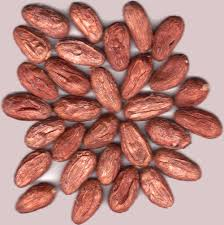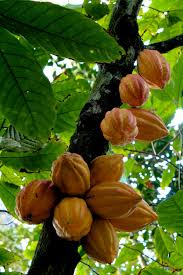Cacao
Scientific Names: Theobroma cacao
Climate: Warm. Warm and humid is necessary for optimal development
Plant Description: Cacao is an evergreen tree with a long trunk, despite being a small species. It is four to eight meters high and five to 20 centimeters wide. It has a main root that grows several meters below the surface of the ground. It has thin, dark green leaves with rounded bases and elongated tips that are arranged alternately. They are between 20 and 35 centimetres long and seven to eight centimetres wide.
Cacao develops small pale yellow to pink flowers that are grouped in clusters that grow directly from the trunk. The fruits are reddish-brown, cylindrical pods containing numerous seeds in a thick flesh.
It is native to the deep tropical regions of Central and South America.
Cultivation: Carefully cut the outside of the pod and remove the seeds. The seeds must come from a ripe pod (seeds rattle when it is shaken) and be no more than 15 days old. The seed should be a deep purple if you cut into it. Clean the pulp from the seeds thoroughly and rub them with a cloth to make sure all the pulp is removed. Plant the seeds in well-drained, loose, moist soil. In order to germinate they must be lightly covered with mulch, and maintained at a very warm temperature (26⁰ C) and consistent humidity. The bed or bag where the cacao is planted should receive partial shade. The seeds will begin to sprout within a week. Cuttings from the tree with one or two leaves can also be sprouted in water and then transplanted, but the success is variable. Seedlings should be maintained in a warm, moist and partially shaded area.
Transplant seedlings (from bags or beds) after six months of growth, at the beginning of the rainy season. Spacing of the plant in the field depends on what other species are being grown (coffee, coco, etc.), but the trees should have 2.5 to 3 meters between them. Cacao responds well to applications of rich compost twice a year.2
Cacao will begin to flower and produce fruit in the third year, but will reach full production in the fifth year.3 The pods can be harvested when there is a change in the color of the skin. Trees generally produce crops two times a year, with pods maturing over five to six months.4
After harvest, seeds can be collected from the pods and fermented for processing into cacao powder and chocolate. With the pulp still on the seeds, beans are allowed to sit for five to eight days, and mixed up every two. This is what brings the color, smells and flavors that we know as chocolate. Without this step, the cocoa beans are too bitter and astringent, and do not develop the characteristic taste of chocolate.
Prune the tree twice a year to allow enough sunlight for fruit to ripen, control height, and remove any dead or diseased branches.
The cocoa tree will make optimal use of any available light and has traditionally been grown under shade. Its natural environment is the rainforest which provides natural shade trees. Shade is very important in the early years of a cocoa tree.
Harvests from the cocoa trees from year to year are affected more by rainfall than by any other factor. Trees are very sensitive to a deficiency of water in the soil. Cacao needs regular rainfall throughout the year. It prefers an annual rainfall level of between 1,500 mm and 2,000 mm.
Cocoa needs soil containing coarse particles and a reasonable amount of nutrients, at a depth of 1.5 m to allow the development of a good root system. Below that level it is desirable not to have any impermeable material, so that excess water can drain away. The cocoa tree is sensitive to lack of water, so the soil must have both water-retention properties and good drainage.
 Uses: Cocoa is mainly used to produce chocolate and cosmetic products. Cocoa butter is used for wrinkles and stretch marks. It also has medicinal properties and can reduce the risk of high blood pressure and heart disease.5
Uses: Cocoa is mainly used to produce chocolate and cosmetic products. Cocoa butter is used for wrinkles and stretch marks. It also has medicinal properties and can reduce the risk of high blood pressure and heart disease.5
Pests and Diseases: Ladybugs can be used to control most of the insect populations which affect the cacao plant and ants have also been used to successfully eliminate insect threats.6
References:
- https://www.worldseedsupply.com/tag/how-to-germinate-cacao-seeds/
- https://www.agrifarming.in/cocoa-cultivation
- See note 2.
- See note 2.
- https://www.webmd.com › vitamins › ingredientmono-812 › cocoa
- https://www.tandfonline.com/doi/abs/10.1080/09670878109413804
En español: Cacao

